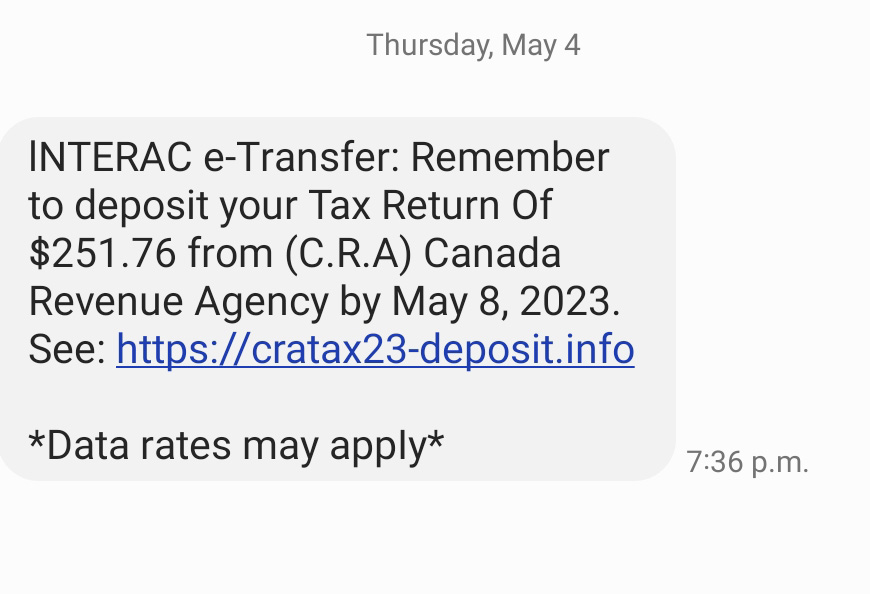It’s one thing to hear about common scams — it’s another to recognize it when it happens to you. To help you spot the warning signs of fraud, we share real-life stories of the types of scams we encounter every day. To protect the identities of those involved, names and details of this story have been changed. As you read the story, try to identify what type of fraud occurred and catch the red flags of the scam.
Brendan has always completed and filed his own income tax each year. When he filed for the 2022 year this past March, he noticed an option to sign up for text alerts from Canada Revenue Agency (CRA) any time there is a new message that needs his attention. He finds his email a bit overwhelming at times and was happy to have the option to receive notifications by text instead, thinking it would ensure he wouldn’t miss anything important.
Nearly two months after he filed his 2022 tax return, Brendan received a text message from CRA advising him that he still had an
Interac e-Transfer® waiting to be deposited. This was surprising because he was certain he’d already received his full refund. The text message included a link to accept the
Interac e-Transfer along with a deadline of when he had to accept it if he wanted to receive the money. Brendan was tempted to click the link, but he noticed a few things he thought were strange about the text message and decided to contact CRA directly before taking any further action.

The scam
Spot the red flags:
When Brendan spoke with a CRA representative, they confirmed there was no outstanding refund on his account and that they are aware of scammers who try to impersonate them. The CRA representative thanked Brendan for contacting them first and went over the ways to know for certain that this message was a scam.
-
Click the link: CRA will not send a message with a link to receive a payment. They might send a message directing you to log into your account, but whenever CRA sends a text message or email they will not include any personal information.
-
Unmatching amount: The amount listed on the text message did not match the amount of Brendan’s refund. This is also a red flag because CRA would not include the amount of the return in a text message. That information is only available through your CRA account.
-
Interac e-Transfer: CRA payments are made either by cheque mailed to you or through direct deposit if you’ve registered for it, but never by Interac e-Transfer. In addition to that, an Interac e-Transfer is always sent from an individual or company bank account, not from the organization themselves.
-
Unusual capitalization and punctuation: One of the easiest ways to tell if a message is a scam is to look at things like grammar, random capitalization, and punctuation. In the example text message pictured above, the words Tax Return Of are capitalized and C.R.A. has periods after each letter, which is not consistent with how CRA is written in legitimate circumstances.
What happens on our side
Brendan was fortunate to know there was something suspicious about the text he received and investigated it further, which prevented him from being scammed. But SCU understands not everyone is as aware of potential fraud. We also know it’s easy to do things without fully thinking them through sometimes, and we encourage you to reach out to us if you have any questions or concerns about a message you receive. Or, if you realize too late that you’ve clicked a link you shouldn’t have and your bank account might be compromised, contact SCU immediately so we can work with you to prevent fraud activity continuing on your account.
Key takeaway: While the sample text message included in this article is an actual text message received by one of our members, be aware that they are not all the same. You might receive a message advising you that you have an unpaid balance, or that there is an issue with your documentation or your SIN. You might even receive a message stating that you are suspected of committing financial fraud. These messages typically also include a threat of some kind; that if you don’t pay you could be fined or arrested, or they request that you send money by way of pre-paid cards or bitcoin. And remember, CRA will never send you an Interac e-Transfer nor will they provide any detail in their messages. They will, however, instruct you to log into your CRA account to view your messages.
Regardless of where it appears to come from, it’s important to be cautious any time you receive an unexpected message with a link in it. Scammers create links that, when you click on them, compromise your device by installing malware or spyware. This allows them to gain access to your bank accounts, email, social media accounts, and any other site you log into from your device and can lead to a loss of money and identity fraud.
Sometimes, we can spot and stop a fraud scam before a member loses money. Unfortunately, this is not always the case. Preventing fraud is an important responsibility we all share. SCU strongly recommends that members remain vigilant and learn to protect themselves from falling victim to fraud.
Visit our Fraud Prevention Centre to learn more about fraud, how to spot it, and if in doubt, reach out to SCU for advice at 1.800.728.6440.
You can also check out the Canadian Anti-Fraud Centre for information on known scams.
Does this story sound familiar?
If this has happened to you, or someone you know, here’s how you can report it:
scu.mb.ca/fraudprevention/reportfraud